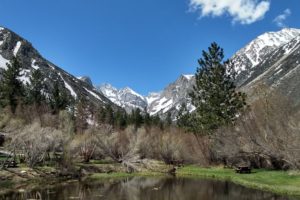We thought we were done exploring until we started driving out and saw some more displays that took us back in time to the siege of Fort Morgan that started days after the Union won the Battle of Mobile Bay on August 5, 1864. This siege was a battle of 2000 against 600. Artillery and naval guns pounded the fort for days, supported by sharpshooters pinning down the men in the fort so they couldn’t shoot back. The final battle started on August 22 and really just lasted one day.

trenches
What we saw along the road that got our attention was the long mound of land on our right.



the Union’s Battery Bailey

Construction began on August 19 of the Union’s battery with 2 artillery positions located only 200 yards from the southeast bastion of Fort Morgan. The position we’re looking at anchored the southern flank of the Federal siege lines. A fierce storm slowed down the building process a little, but the battery was ready for the guns by the morning of August 20. That day, two 3-inch ordnance rifles and two 12-pounder “Napoleons” of the 2nd Connecticut were moved across Mobile Bay from Fort Gaines. The 2nd Connecticut and its guns were within easy range of Confederate heavy artillery, and the infantry was ready on the counterscarp (the outer wall of a ditch in a fortification).


siege of Fort Morgan


Fort Gaines was just across the mouth of Mobile Bay from Fort Morgan. We had wanted to go there on a ferry that connected the 2 sides of the entrance to the Bay but ran out of time. Next trip.
After the South surrendered Fort Gaines on Dauphin Island on August 8, U.S. General Gordon Granger set his eyes on Fort Morgan. On August 9, he moved his 2000 men and siege equipment just down the road east from Fort Morgan. By 2:00 p.m. his men had built a line 2000 yards from the fort.
That afternoon General Farragut bombarded Fort Morgan for several hours from a distance of up to 1400 yards. Under a flag of truce, the Union demanded the fort’s unconditional surrender. Confederate General Richard Page refused, even though he had fewer than 600 men ready to fight.

From a distance, Fort Morgan would have looked like just a pile of sand to the Union soldiers. But everyone knew that its brick would crumble if hit enough by the Federals’ heavy shells, regardless of its 40-foot sand glacis (cleared ground that sloped upward toward the fort). Inadequate traverses (protected walkways) and weak casemates left the men inside vulnerable, so the garrison worked day and night to strengthen what they could.

This map shows the Union assault on Fort Morgan.

On August 10, the Union Army and Navy had completed their first parallel operation by mounting their siege guns, including a naval battery. On August 15, their 2nd parallel operation started just 500-700 yards from the fort. By August 21, the Union sappers (military specialists in field fortification work) approached to within 200 yards of the glacis. Their big guns moved closer too.
After August 9 (can’t you just imagine the heat and the mosquitoes?), both sides continued working under fire from cannon and sharpshooters. The fire from the monitors on Mobile Bay were always accurate, frequently striking the ramparts (tall, thick stone or dirt wall that is built around the fort to protect it from attacks) or exploding in the fort. The greatest danger to the men was from flying bricks.

Confederate batteries, according to Samuel Crawford of the 20th Iowa, “appear to be terrible full of fight.”
On August 22, the Federal fleet encircled the fort and a 24-hour bombardment began from land and sea. According to an observer, once the Yankee artillerymen got the range, every shell they fired went into the fort, dismounting guns, partially breaching walls, and starting fires. The citadel caught fire and, burning fiercely, threatened the powder magazine. As we read in the previous post, the fort’s commander had all the powder brought out and poured into the cisterns so it wouldn’t blow up and destroy everything around it.

According to Robert Tarpley of the 1st Tennessee Heavy Artillery who was in Fort Morgan at the time, “[Emptying the powder into the cisterns] was a terrible job. The powder was in kegs. These we had to roll under the flames of the citadel and knock the heads in, then pour the contents in the cistern. All this time the enemy kept up a continual fire from land and sea. The shells were bursting all round us. By one o’clock we had all the powder under water. There was not enough dry powder to shoot a musket.” Oops, they should have left some to use.

The following picture shows the destruction of the citadel after the fire.

General Page raised a white flag at 6:30 in the morning and surrendered unconditionally at 2:00 that afternoon.
Federal siege line

We’ve already covered this siege, so I’ll only highlight that we haven’t seen before.

The Union’s goal of this fight against the soldiers at Fort Morgan was actually Mobile. “Every one of our boys stood at their post determined on the reduction of the long boasted hope of Mobile.”

An Iowa soldier described the gunner’s hard work. “The mighty work continued all day long, with unabated grandeur. The gunners seemed to perform their duties with enthusiasm. Stripping themselves of all superfluous clothing, and blackened, begrimed with the smoke, and dirt, and sweat of battle, their eyes sparkling through the hazy air with the glare of enthusiasm amounting almost to frenzy, they might have well been taken for so many Vulcans forging thunderbolts for the gods.” Bet those inside the fort weren’t so excited.
When the white flag went up, the firing from the Federal artillery ceased and again silence settled over Mobile Point. “So great was the contrast for a moment, that the silence was such that it might have been felt. It was suddenly broken by the cheers of our troops and sailors, whose thousands of voices in long continuous shoutings came near equaling the noise of the bombardment.”

The battle for Mobile Point is over. The Union’s next prize will be Mobile, and we covered that win in previous posts about Fort Blakeley earlier in our trip to southern Alabama. Now that we’ve looked at what happened before 1864, let’s turn to the end of the century and the beginning of the BIG guns as we start walking around the outside of Fort Morgan.




